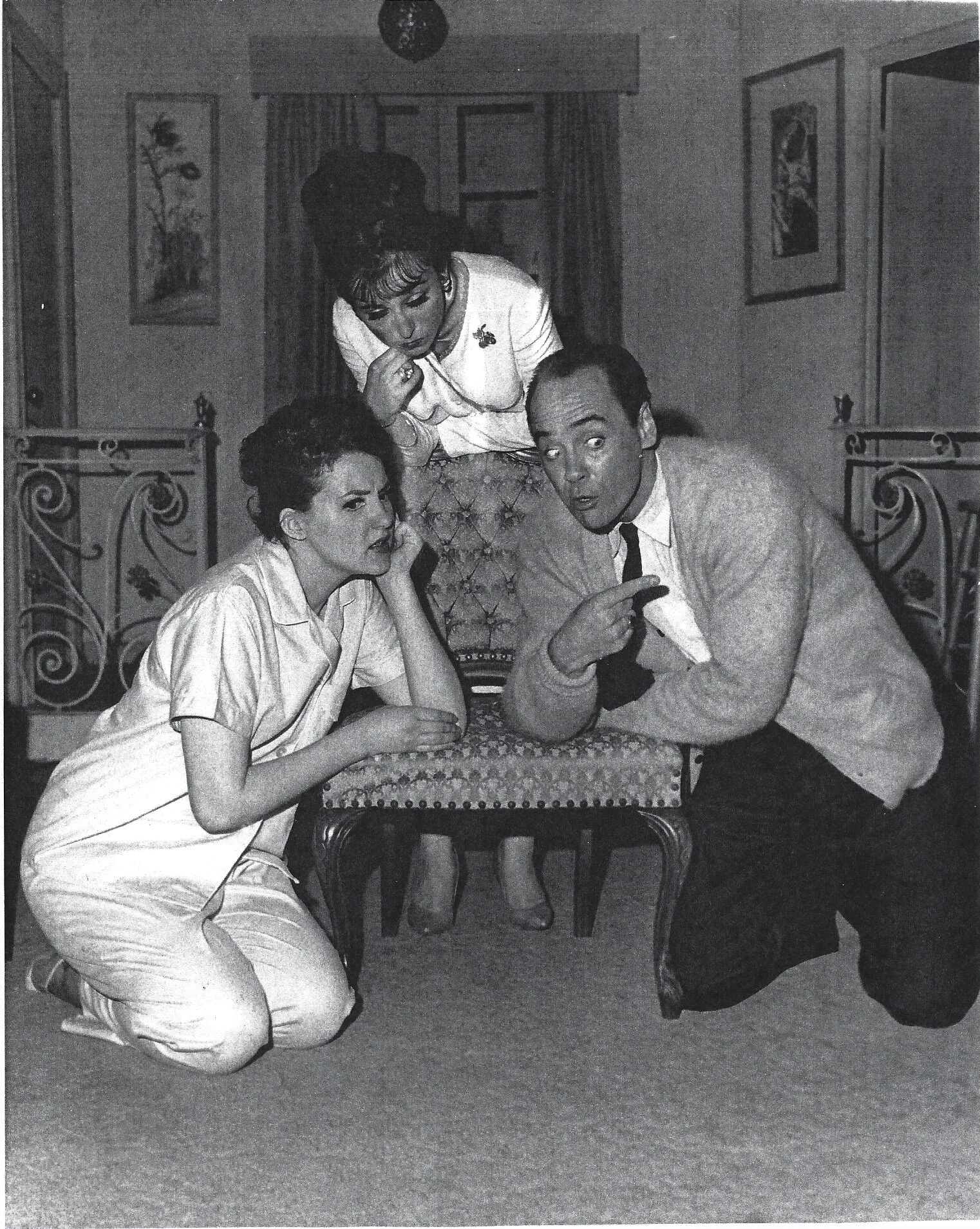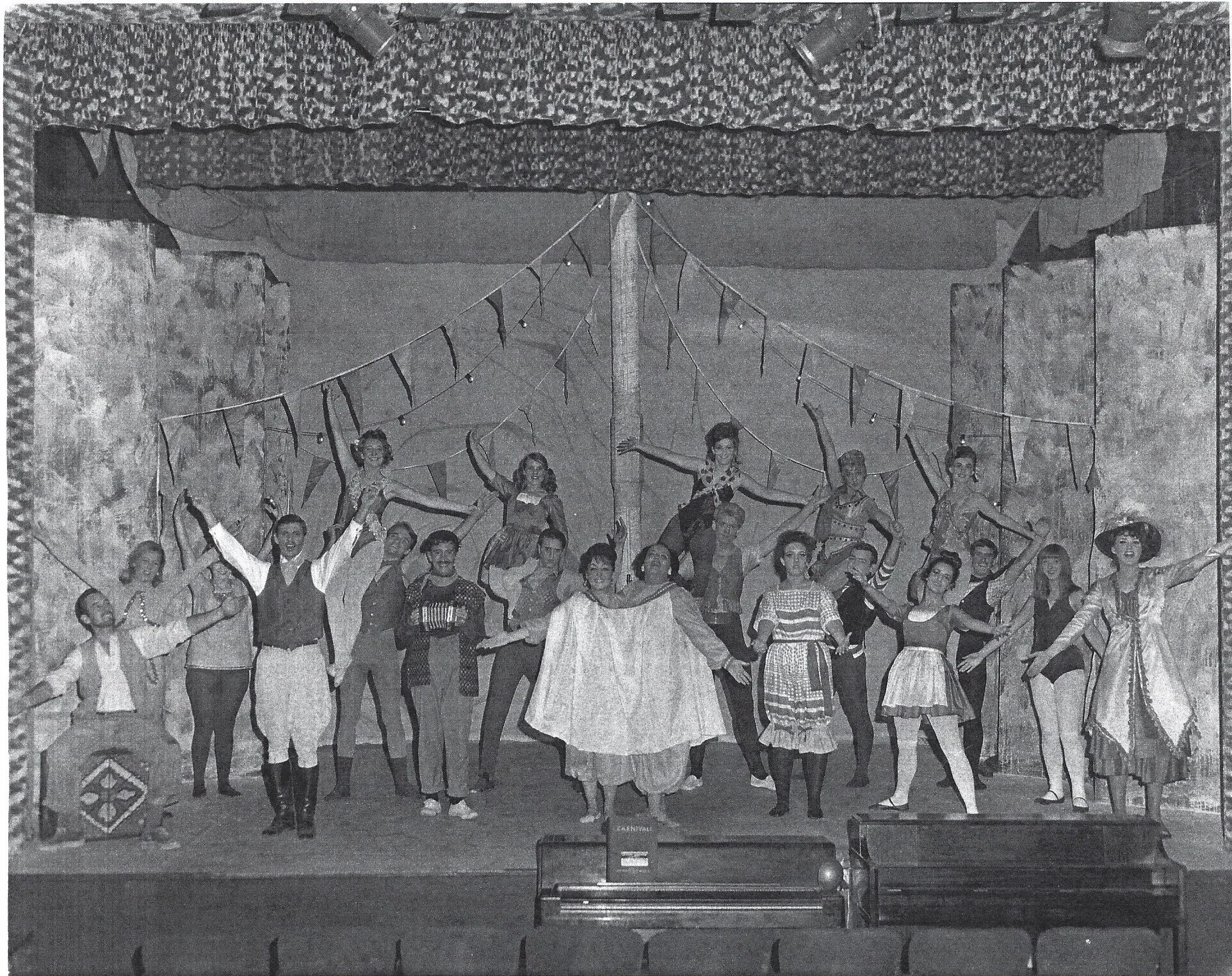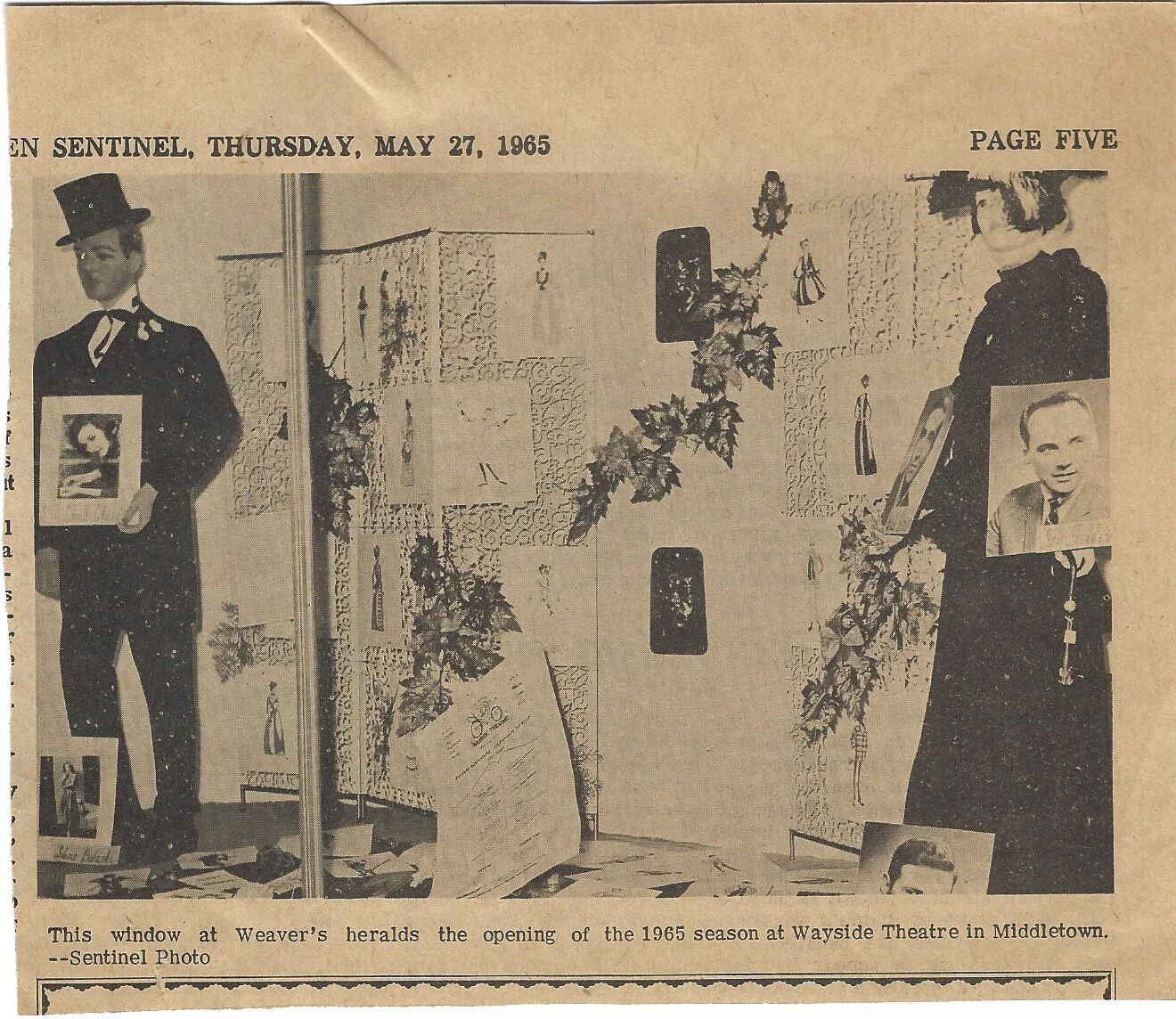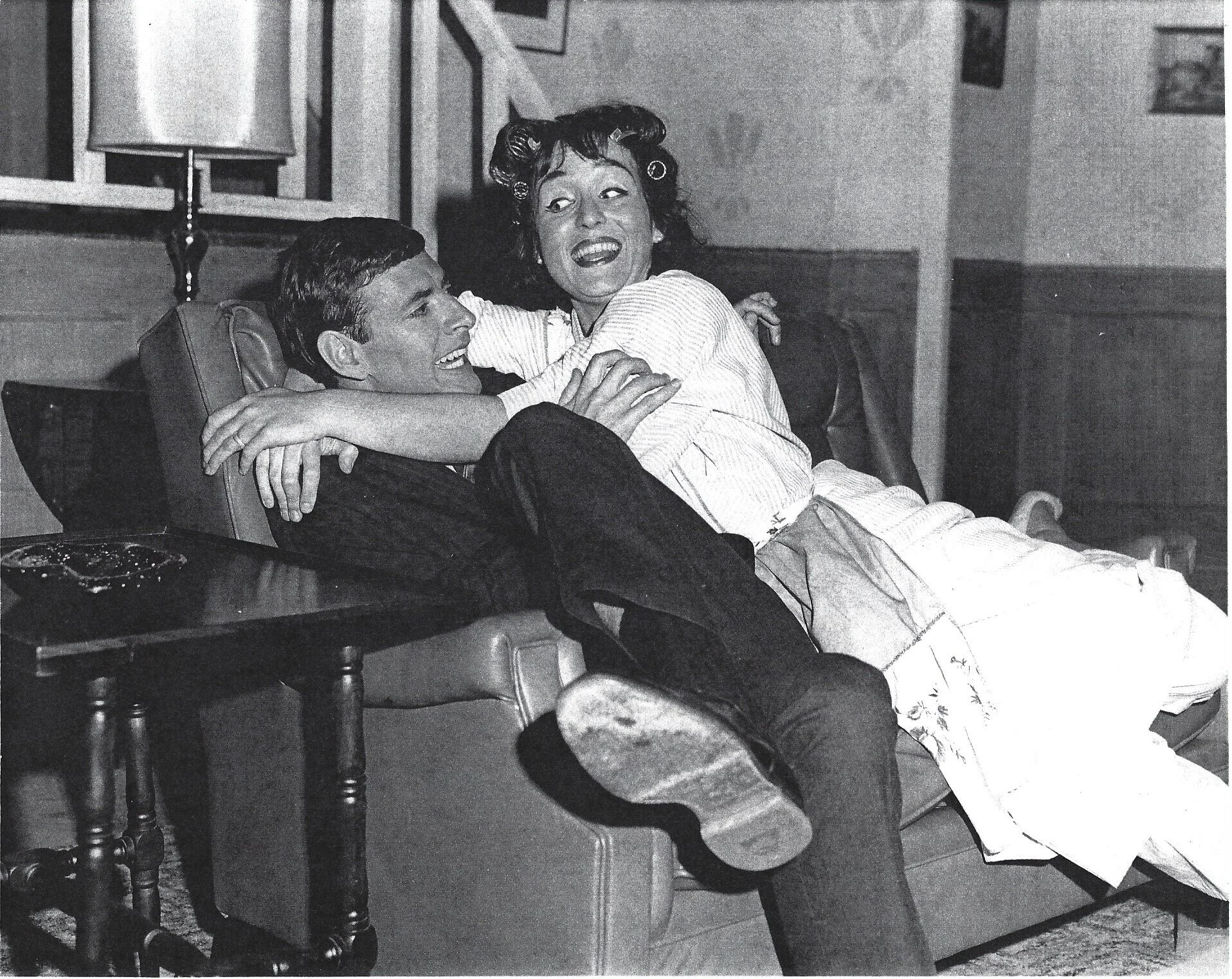Owen Phillips: 1965
Based on available information, it appears that the fledgling theatre’s 1965 season was, once again, very successful. During the previous year, the press wrote extensively about the change in the theatre space. A year later, the newspaper articles feature others topics, such as the work required to mount a production and the pressure to get things done in a short amount of time. “In the summer, a new play is produced every [week or every] two weeks. Approximately 75 hours of rehearsal each week is required. During the day they rehearse next week’s production, while that night they give the present week’s production” (Pennypacker. “Theatre Ready ….” WES. 22 May 1965). During Wayside’s early years, the “play a week” schedule was the norm.
Before the actual 1965 summer season opened, Wayside hosted a Winter Series Event, with a reading of The World of Carl Sandburg performed by members of the Holy Trinity Mission Seminary on January 30 and 31, 1965. The performance used three readers, one guitarist, and four singers. Describing this, Dillard stated that the singers were “men with well trained voices who sing the ballads as if they love them” (Dillard “ ‘The World of Carl Sandburg’ ….” WES. 3 Feb. 1965). This work had had a successful run on Broadway as well as a national tour starring Bette Davis and Lief Ericksen. There is virtually no other information regarding the Wayside performance.
Mary, Mary, May 28 - June 12, 1965. Carol Churas, Ilona Dulaski, Ian Sullivan.
The opening production for Wayside’s 1965 summer season was Jean Kerr’s Broadway hit, Mary, Mary. The opening night performance was “presented with the finesse and flair of a Broadway show,” said one reviewer. “[It was] a glittering affair for the people of the area [who] are so proud to have a professional theatre in their midst that they turned out in long ballgowns and jewels. The crowd was sophisticated, many being visitors from Washington, DC …. The cast was superb. [Ian Sullivan and Carol Churas] handling their roles with such ease that they seemed to fit them like a glove” (“Wayside Theatre Has ….” TDM. 1 June 1965). An extensive bio of Carol Churas had appeared in the local press prior to the opening illustrating the type of coverage given to members of Wayside’s acting company at that time. (Dillard. “Carol Churas Playing ….”WES. 9 June 1965).
One writer, reflecting on the changes taking place in the Middletown, stated, “Would anyone ten, or even five years ago, dream that the village of Middletown would someday become an educational center of the arts,” and eloquently continues, “that Bernstein’s purchase of the Inn was the catalyst that began the whole process” (Pennypacker. 22 May 1965). The headline in another paper heralded the Theatre’s third season stating,
Virginia isn’t far ‘off-Broadway.’ There is theatre beside the wash of the Atlantic breakers, in restored colonial taverns and inns, in mountain hamlets and museums.
One of the most prominent of these theatres is the Wayside Theatre in Middletown, Virginia, an all-professional Equity company sponsored by the non-profit, educational Wayside Foundation for the Arts, Inc. Here, under the direction of Mr. Owen Phillips, well-known in the Miami, Washington, New York and Virginia circles for over twenty years, a resident company of hand-picked actors perform quality theatre. The support and recognition accorded the theatre during its first three seasons has encouraged it to take the giant step which will greatly increase its potential for contributing to the educational and cultural life of the northern Shenandoah Valley …” (Scrapbook, 1965. Un-dated clipping).
Carnival. April 19 - 27, 1964.
In one review, the list of plays scheduled for the summer season also included the titles for the extended fall season. The writer’s enthusiasm for the upcoming season shows when she states that the previous year had been “praised by critics [due to] their professional caliber” (Scrapbook. 1965. Un-dated clipping).
In reading Polly Dillard’s reviews found in the Front Royal paper, The Warren Sentinel, one grasps the weekly chronicle of Wayside’s productions. Since the resident company members all took part in the majority of the plays, the readers would see the names of the same actors as they appear in various roles. Dillard, along with the other reviewers, would make comparisons as the actors moved from one role to the other. She makes the reader feel as if she is seeing these actors as old friends. In commenting on Mary, Mary, she states, “It is wonderful to have Ian Sullivan back at Wayside for the third year … an actor, who can dig his teeth in and come up with a stunning performance.” She refers to Hal Herman as an actor whose “personal warmth adds a needed third dimension [to the character] and keeps him interesting” (Dillard, “Wayside Review.” TWaS. 3 June, 1965). In reviewing Carnival, Dillard labels Steven Levi as Wayside’s “song-and-dance man … [who is] a convincing lady killer, too” (Dillard. “Wayside Review.” TWaS. 12 Aug. 1965).
An anonymous editorial, written after the opening of Mary, Mary, awards four ‘plaudits’ to the production, stating, “Upon the opening of the 1965 season, Owen Phillips and his cast have a ‘smash’ in their opening production, ‘Mary, Mary.’ Lines are clever, timing superb and the casting is excellent. With a start like this, the season can only be a tremendously successful one.” Further in the review, the writer expresses his appreciation that Wayside had made its home in the Valley. “We will never be able to measure how fortunate it is in having the pleasure of professional summer stock [company] and in having a cultural attraction that people come from far away to enjoy” (Editorials. TWaS. 3 June 1965).
In her lengthy reviews, Dillard shares her impressions and opinions of the production along with interesting insights about the costumes, lights, and sets. One of the most amusing comments she made is found in a review of Take Her, She’s Mine, when she refers to “That famous stage couple, Harold Herman and Lindé Hayen … who have played husband and wife so often they should file a joint tax return!” (Dillard. “Wayside Review.” TWaS. 29 July, 1965). It should be mentioned, that Hal and Lindé worked at Barter Theatre the following year where they were married between a matinee and evening performance of the show they were performing! A few years later, they returned to Middletown and lived in the house that had been used for actor housing. They also created the theatre program at Shenandoah College and Conservatory of Music, now Shenandoah University.
The Winslow Boy, June 28 - July 10, 1965. Lindé Hayen (L), Ilona Dulaski, Steve Levi, Hal Herman, Drix Nieman, Carol Churas.
Leo Bernstein used both the Inn and the Theatre to attract visitors from DC. For one particular event, the Assistant Chief of Protocol, Barbara Bolling, and her fiancé, Alexander Hamilton, along with the assistant Postmaster General, Congressmen from Wisconsin and New York, local lawyers and heads of various industries, were hosted at an informal gathering at Bernstein’s Georgetown home. Once everyone had arrived, the guests boarded a bus for Middletown to enjoy a southern dinner at the Inn. Because of traffic most likely, “Mr. Bernstein’s party delayed the opening of the Wayside Theatre’s production of The Winslow Boy, a short time,” but, the writer continues, “it was well worth the waiting. And, of course, all the ‘locals’ were dying of curiosity as to who these ‘important people’ could be” (Pennypacker. “Washington VIPs ….” WES. 1 July 1965). After the performance, the DC guests returned to the Inn for entertainment by “the actors and actresses who were in the play as well as with other members of the Wayside Theatre. It was better than a ‘backstage party.’ ” Pennypacker concludes by adding that all the guests stayed overnight at the Inn before boarding the bus the next day for the return trip to DC. It was excursions such as this that helped promote Wayside Theatre and tourism in the Shenandoah valley to those living in the nearby metropolitan areas.
A Maryland writer, attending a Wayside performance, was surprised at the quality of the professional talent that performed on the theatre’s stage. She obviously did not know the history of the building where the production took place, because she wrote, “The theatre seems as if it might be converted from the town’s opera house for it has a balcony, and has been refurbished with a brilliant red and gold finish. Next door is an Art Gallery, and overall, it now bears a sophisticated air!” (Powell, L. “Feminine Perspective.” TDM. 4 June 1965).
Both Owen Phillips and Leo Bernstein exerted a great deal of effort in promoting the Theatre. On one occasion, Phillips was feted by Bernstein at a DC reception,
where the 175 guests at Mr. Bernstein’s Kalorama Road home learned of plans to
form a Board of Directors comprised of Northern Virginia civic and social leaders
to guide the future of Wayside Theatre …. Mr. Phillips and Mr. Bernstein jointly announced the coming incorporation of the Wayside Foundation for the Arts Inc.,
whose work in cultural contributions to the Shenandoah area will be piloted by
Phillips as Executive Director of the non-profit organization ….
As always, for these events, the guest list was mixed. Included on this particular occasion were,
State senators, the head of Foxcroft School, congressmen, … the Ambassadors
of Austria, Ireland, and Norway …” and others. “Long range plans for the Foundation include educational and expense-grants for promising actors and actresses, authors, directors and scenic designers, a functional theatre-workshop expanding upon last winter’s successful workshop at the Wayside Theatre, and a closer liaison with area schools ….
To conclude the evening, Phillips announced that, “Our purpose is to make it possible for talented persons [to participate] who might never otherwise develop their talent to create to their fullest capacity” (“Phillips Honored …” TWaS. 27 May 1965). According to records, The Wayside Foundation for the Arts became a reality on July 29, 1965. At this time, Bernstein turned over his ownership of the theatre to the Foundation, charging the huge amount of $1.00 as the annual fee. Prior to this, Bernstein owned both the Wayside Inn and the Wayside Theatre. With the creation of the Foundation for the Arts, Bernstein passed ownership of the Theatre to that organization while retaining ownership of the Wayside Inn.
One example of how the Theatre was making inroads into the community was seen when some area stores decorated their windows to celebrate the opening of the 1965 season. The window display of Weaver’s, the Front Royal shoe salon, consisted of mannequins dressed as various actors, either from plays from previous years or the upcoming season. The display included a poster that announced Wayside’s 1965 season along with some costume sketches and some headshots of the actors hired for the season. It is unfortunate that the photograph of this display that appeared in the newspaper is not very clear, making it difficult to determine what was shown (“1965 Season …..” TWaS. 26 May 1965).
A similar window display appeared in Margaret L. Hodgeson’s Hat and Dress Shop on Loudoun Street in Winchester: One window contains
… An all white 1900’s ensemble [that] features a linen ankle length shaped gown
with hand-embroidered crochet-work at the neck, hem and sleeves. The model
carries a white fur fan and a beaded evening bag.
The second model carries a pale pink ivory and feather fan which complements
her 1930’s evening gown of beige taffeta with fuschia velvet ribbon accenting the flounces. Her evening bag is also hand beaded.
Costume sketches of the “Gay Nineties,” Medieval and 15th Century periods of
Maida Murray, the Wayside Theatre’s new costume designer, line the walls, while programs, a top hat an authentic cane belonging to Owen Phillips … and antique
fans are artfully displayed (Borgen. “Window Display ….” WES. 26 May 1965).
In the second window, more contemporary clothing was shown. One was an outfit that a well-dressed person would wear to the opening night performance of Mary, Mary.
All are in summer’s smartest color: lemon ice. For the woman who prefers a long
gown, there is a full length crepe with a bodice beaded in rhinestones and moonstones. For the very young at heart (and young in size) there is a lemon-green-and-blue chiffon print designed with rows of flounces accented by a self belt at the waist. Finally there
is another lemon ice crepe, this one short with a beaded cummerbund (Borgen. 26 May 1965).
Turning from opening night fashions, one is reminded that the area of education continued to be a major emphasis for the theatre. One announcement told of the formation of a Wayside Theatre Workshop Class entitled, “Learn to Act by Acting” and stressed the importance of teaching drama in schools and listing the advantages by doing so (1965 Scrapbook. Un-dated clipping).
These reasons were also supported by the Headmaster of Powhatan School, Don Niemann, who had appeared with his son, Drix, on the Wayside stage. Nieman states,
I’m not trying to turn my students into professional actors. But, there are three good reasons for a strong dramatic program in school. First, it teaches the children self-confidence … it involves teamwork just as a sports team … and, finally, much of our
good literature is in the form of plays which are meant to be acted, not read. Elementary and high school students are quite able to put on worthwhile plays and in this way they can learn to understand dramatic literature (Dillard. “Wayside Review. TWaS. 8 July 1965).
Never Too Late, July 12 - 24, 1965. Bill Anderson, Ilona Dulaski.
It is possible that the acting classes for adults, along with the desire to use local talent, was the reason Phillips chose to mount a production of Clare Luce’s play, The Women. There are conflicting reports as to the performance dates for the play: was it 1964 or 1965. It is known that performances were scheduled on weekends after the regular summer season had closed. With such a large cast of characters, ample opportunity was provided for people in the community to take part. High praise was given to Phillips’ direction of the production as well as to the cast, calling the play, “a true toast. They are individuals … they are having and giving so much FUN …” (Gilpin, “ ‘The Women’ Delight ….” WES. 6 Dec, 1965).
In addition to producing a summer season of plays and teaching acting classes, Phillips widened the Theatre’s exposure through a ten-day Arts and Drama Festival. Unfortunately, there is little documentation for this event other than it did take place, and that the visual portion of the event was connected with the Fine Arts Museum in Richmond exhibiting paintings, drawings, and sculpture.
Picnic, Aug. 23 - Sept. 9, 1965. Charla Hayen (L), Hal Herman, Jane Caspar, Lindé Hayen, Ilona Dulaski.
The price of theatre tickets in 1965 is of interest to modern readers. They ranged from $2.25 to $2.75, with curtain times listed as: Monday through Friday, at 8:40 p.m. and Saturday evening performance at 9:30 p.m. There was a Wednesday matinee at 2:30 p.m. and a Sunday twilight performance at 6:30 p.m.
An unsolved problem for 1965 has surfaced. On an 8.5 x 11 piece of paper, most likely inserted into the playbill, there is a brief bio of actor, Ian Sullivan that extends a welcome-back to him, stating, “he has been a favorite with theatre-goers in the Valley for the past two seasons.” Was this the practice of the Theatre for every returning actor, or was it just extended to Sullivan? Who knows.
Printed at the bottom of the page, the theatre goer is reminded, “Listen every Tuesday morning to WAYSIDE REVIEW on the Joe Pasquale Morning Show on Radio Station WINC.” Unfortunately, nothing is available that tells about these radio broadcasts, but most likely it featured someone from Wayside’s acting company or staff who was interviewed each week about some activity at the Theatre. Neither John Lewis nor David Lewis, former owners of WINC, recall this program (Lewis, John. Email. 4 Sept. 2016).
NOTE: Lewis mentioned in an email that WINC bartered a deal with the Theatre in
which WINC would provide an advertising schedule in exchange for a performance
tickets solely for invited guests (sponsors usually). He stated, “I do remember when Wayside purchased radio time but never paid for it.”





